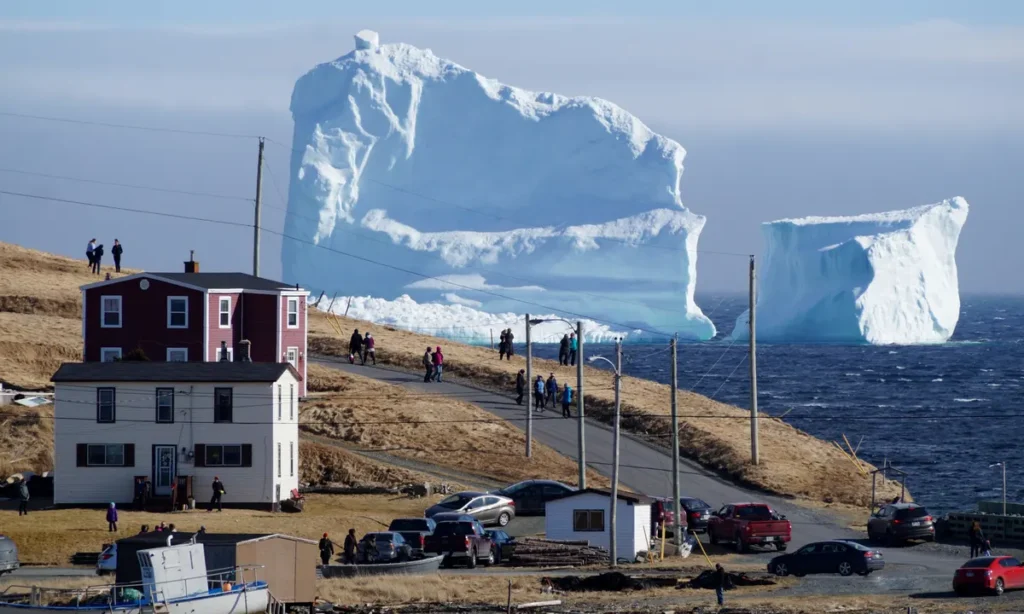What Is An Iceberg Alley?
Between late April and early June, locals and visitors along Iceberg Alley stand on a rocky coast and watch a colossal iceberg slowly drift by.
Table of Contents
What is an Iceberg Alley?
Iceberg Alley refers to the waters of the Atlantic Ocean that run along the coast of Newfoundland and Labrador, at the easternmost point of North America.

Here are the 11 Cool Facts about Iceberg Alley
Iceberg Alley is where the Titanic Sank
There is a truth to the expression “the tip of the iceberg,” in which only a tiny portion of an iceberg can be seen above water. This saying is familiar to those who know the story of history’s famous maritime disaster.
In Iceberg Alley, the ill-fated Titanic collided with an undetected iceberg. After the incident, Canada, the United States, and 12 other countries formed the International Ice Patrol to warn vessels of any large, frozen obstacles floating around the North Atlantic.
Between 400 to 800 icebergs move past Iceberg Alley every year.
Every spring, hundreds of icebergs slowly make their way past Iceberg Alley. From small chunks called “bergy bits” and “growlers” to colossal structures that loom over small villages.
The iceberg breaks off of glaciers in Greenland and travels south.
Spring means the melting of ancient glaciers in the North Atlantic Ocean. As the weather gets warmer, giant swaths of frozen water break off from Greenland’s ice shelves and glaciers. They then begin a journey south along Iceberg Alley that lasts months from the time they calve-break off from the glacier until they entirely melt into the sea. This phenomenon is called caving.
The bulk of the ice calving from Greenland’s glaciers forms icebergs. While about 10-50 percent of these icebergs melt directly in Greenland’s fjords, the majority are carried away by ocean currents.
The Greenland ice sheet results from thousands of years of snow accumulation that has reached a thickness of more than one kilometer (1 km). The pressure that comes from the enormous weight transforms the snow into ice. The same pressure pushes the glaciers – rivers of ice funneled by numerous fjords – towards the ocean, where they calve and form icebergs.
A subset of these icebergs will reach Newfoundland, mostly from Greenland’s west coast. While these icebergs can live for as long as a decade, those reaching Newfoundland are generally one to two years old.
The icebergs only travel at an average of 4.0 miles per hour or up to 10 miles daily. Still, their speeds depend on many factors, such as ocean currents, wind, and waves.

Icebergs come in different distinct shapes in Iceberg Alley.
As icebergs melt, they take on many different forms, creating magnificent shapes and arches until the last bits melt into the sea.
The six (6) categories of appearance:
- Blocks. Square-shaped icebergs with steep sides and a flat top
- Wedges. Have a flat surface that slopes from one end to the other.
- Pinnacles. A pinnacle or peak shape is offered as a pyramid.
- Dry docs. U-shaped icebergs have a flat water-level section in the middle with two pinnacles or columns on either side.
- Domes. Softly rounded
- Tabular. They have flat tops much greater than their height.
What is the Iceberg Capital of the World?
Twillingate is unofficially known as the “iceberg capital of the world” for being one of the best spots on the planet to see the glacial monoliths. From Twillingate, you can take one of the boat or kayak tours to get up close to the icebergs. Another option is to hike along the eastern side of Spiller’s Cove Coastal Trail or walk up to Long Point Lighthouse to get the best views of any icebergs adrift at sea.
You can track the icebergs’ movement along Iceberg Alley.
Spring in Newfoundland brings people determined to lay their eyes on one of the colossal ice giants. For anyone interested in iceberg movements, a simple tracker can help; it lets users locate and trace the movements of the many icebergs making their way south.
The iceberg creates vibrant underwater ecosystems in Iceberg Alley.
The waters in Iceberg Alley are rich ecosystems that feed whales, seals, and other marine life. This is because the iceberg breaks off from the bottom of a glacier, bringing soil and other land-based nutrients into the sea. Also, when the large icebergs scrape the bottom of the ocean, they release the rich nutrients trapped on the seafloor. When they melt, the freshwater creates small currents within the salty sea; these are excellent conditions for zooplankton and phytoplankton. The presence of this plankton makes the waters of Iceberg Alley prime feeding grounds for many aquatic animals.
You can sometimes hear the iceberg break apart.
As an iceberg melts, its weight shifts, creating an imbalance and often forcing it to tip to one side. Sometimes, this event causes the entire iceberg to roll over. The force of the movement can be so great it makes the iceberg explode, sending shards of frozen water into the air.
Locals compare the sound of this breaking up to the boom of a cannon.
The best way to see the icebergs is to get up close by boat.
St. John, the capital city of Newfoundland, has boat tours that take visitors close to the icebergs, providing a unique perspective of these ancient, floating blocks of ice. The captain of the vessels is experienced in navigating the tricky waters around icebergs. Adventurous people may choose a kayak or take a Zodiac out to get a better view.
You can toast a trip to Iceberg Alley with a drink of iceberg water.
People from Newfoundland have found an innovative use for iceberg water. They make beer, wine, and vodka with it. Boats trawl the seas around Newfoundland, collecting pieces of ice that have broken off. Once assembled, it’s melted down and added to select beverages. Toss an ice cube from a berg into a drink for some extra fizz and crackle while taking in the spectacular sights along Iceberg Alley.
Icebergs aren’t the only things to see along Iceberg Alley.
They are also famous for fish and chips in one of the historic seaside villages. Moreover, the wildlife viewing is incredible too. The waters are home to minke, sperm, and humpback whales. The rocky cliffs abound with seabirds, including the 500,000 Atlantic Puffins who nest at the Witless Bay Ecological Reserve. The area is also home to some of North America’s most astounding numbers of bald eagles. Moose are not an exception in this area, and the government estimates that 110,000 moose habit Newfoundland.
Fact: Newfoundland is one of the foggiest places on the planet.





